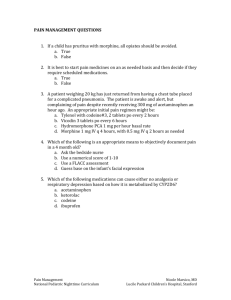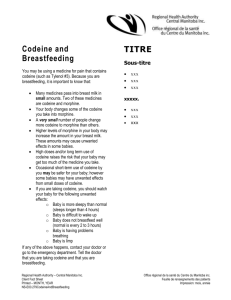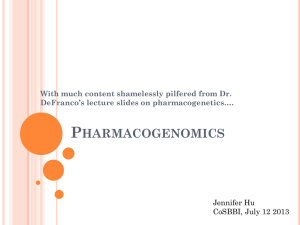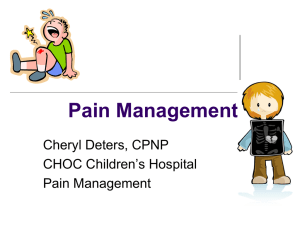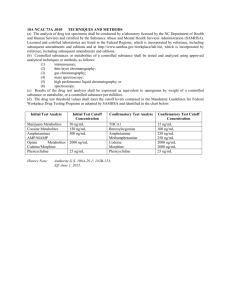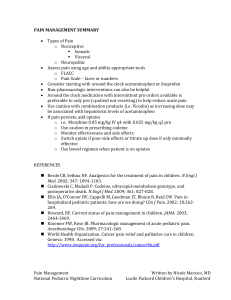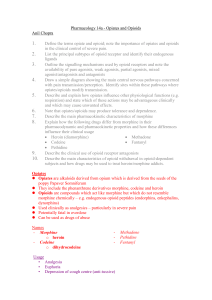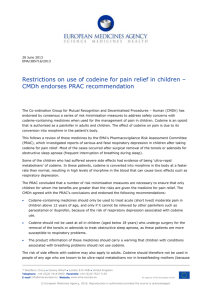Pharmacogenetics of Fatal Morphine Poisoning in a
advertisement
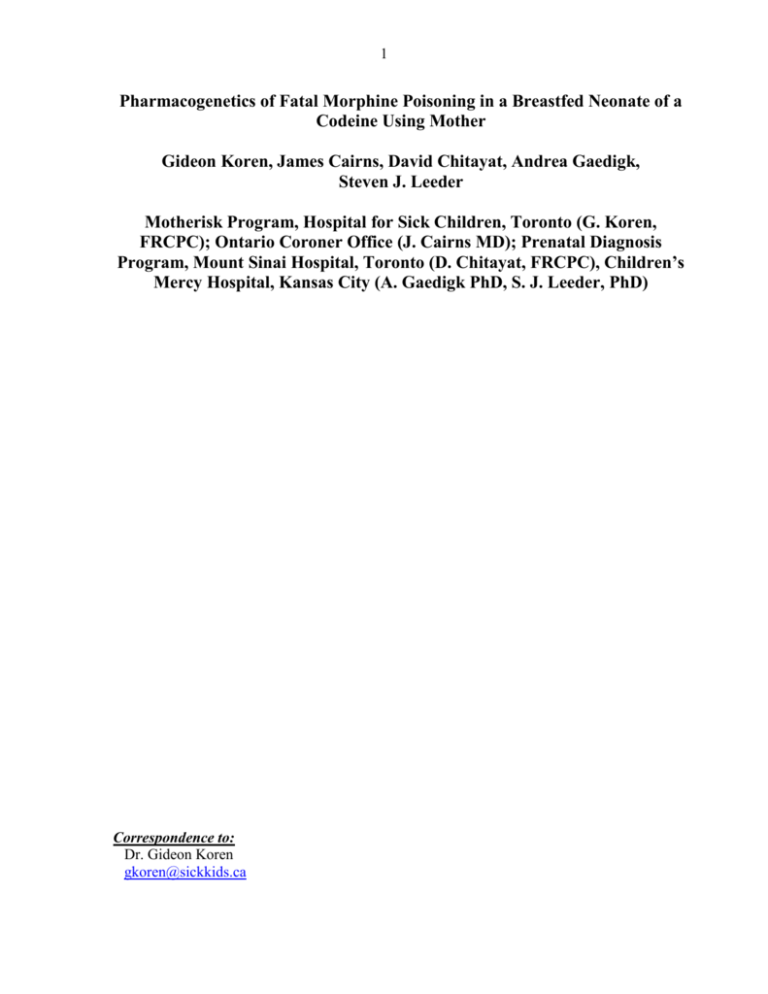
1 Pharmacogenetics of Fatal Morphine Poisoning in a Breastfed Neonate of a Codeine Using Mother Gideon Koren, James Cairns, David Chitayat, Andrea Gaedigk, Steven J. Leeder Motherisk Program, Hospital for Sick Children, Toronto (G. Koren, FRCPC); Ontario Coroner Office (J. Cairns MD); Prenatal Diagnosis Program, Mount Sinai Hospital, Toronto (D. Chitayat, FRCPC), Children’s Mercy Hospital, Kansas City (A. Gaedigk PhD, S. J. Leeder, PhD) Correspondence to: Dr. Gideon Koren gkoren@sickkids.ca 2 Case: A full term healthy male infant, delivered vaginally, who was breastfed by a codeine-using mother, exhibited intermittent periods of difficulty in breastfeeding and lethargy starting on Day 7. On Day 12 he exhibited grey skin and decreased milk intake. Subsequently, he was found dead on Day 13. Postmortem analysis showed no anatomical anomalies and blood morphine concentration (the active metabolite of codeine) of 70 ng/mL by gas chromatography-mass spectrometry (GC-MS). Neonates breastfed by mothers receiving codeine-typically have morphine serum concentrations of 0-2.2 ng/mL(1). The mother was prescribed Tylenol 3 (codeine 30 mg and acetaminophen 500 mg) after birth for episiotomy pain (initially 2 tab. 6 hourly and half that dose from Day 2 due to somnolence and constipation). She continued Tylenol 3 for two weeks. Due to poor neonatal feeding, she stored milk on Day 9 which was measured for morphine by specific ELISA and GC-MS at 87 ng/mL. Typical milk levels after repeated maternal codeine range from 1.9 to 20.5 ng/mL at doses of 60 mg q6H. Genotype analysis was conducted for cytochrome P450 2D6 (CYP2D6), the enzyme catalyzing the O-demethylation of codeine to morphine(2). The mother was heterozygous for a CYP2D6*2A allele with CYP2D6*2x2 gene duplication, classified as an ultra-rapid metabolizer. This genotype leads to enhanced formation of morphine from codeine, consistent with the somnolence and constipation experienced by her(3). The maternal grandfather, the father and infant possessed two functional CYP2D6 alleles (CYP2D6*1/*2 genotypes, classified as extensive metabolizers. The maternal grandmother was an ultra-rapid metabolizer (Figure ). 3 The clinical and laboratory picture in this case is consistent with opioid toxicity leading to neonatal death. Most of the analgesic and CNS depressing effects of codeine are secondary to its metabolism to morphine by CYP2D62. The high milk level of morphine corroborates the clinical picture in the infant. Milk was available only at half of the initial codeine dose; conceivably peak milk concentration of morphine was higher. Codeine is a commonly used analgesic after labor for pain associated with episiotomy and caesarian section. The American Academy of Pediatrics lists codeine as compatible with breastfeeding, despite lack of sufficient published data to support this recommendation(4). Because the vast majority of pregnant women initiate breast feeding, the safety of codeine during breastfeeding must be established. This case reveals that polymorphism in CYP2D6 may be life threatening for some breastfed babies. Given that a CYP2D6 ultra-rapid metabolizer genotype occurs in 1% in Caucasians and up to 30% in some parts of Asia and Africa(5), this polymorphism is clinically important. Several strategies can be considered to prevent life threatening neonatal toxicity (Table): 1) Avoiding breastfeeding in cases of maternal use of codeine. While this approach can prevent neonatal toxicity, it would prevent the benefits of breastfeeding from thousands of infants. 2) Genotyping all postpartum women who are planned to receive codeine. 4 This strategy would identify CYP2D6 ultra-metabolizers who are at risk of neonatal poisoning. Presently this test is not available in most clinical facilities. 3) Careful follow up of all women on codeine, and testing mother-child pairs when the mother is experiencing symptoms consistent with opioid toxicity. 4) Following up closely all breastfed infants of codeine-using mothers and test morphine levels whenever there are adverse events consistent with opioid toxicity. Morphine measurement is not routine in most facilities. In any suspicious case, naoloxone may reverse and thus corroborate opioid toxicity. Whatever clinical approach is taken, codeine cannot be considered as a safe drug for all infants during breastfeeding. To the best of our knowledge, this is the first record of a breastfed baby succumbing to toxicity through breastmilk. 5 REFERENCES: 1) Meny RG, Naumburg EG, Alger LS, Brill-Miller H, Brown S: Codeine and the breastfed neonate. J Hum Lact 1993; 9: 237-40. 2) Meyer UA. Pharmacogenetics of adverse drug reactions. Lancet 2000; 356: 1667-71. 3) Gasche Y, Daali Y, Fathi M, Chiappe A, Cottini S, Dayer P, Desmeules J: Codeine intoxication associated with ultrarapid CYP2D6 metabolism. N Engl J Med 2004; 351: 2827-31. 4) Committee on Drugs. American Academy of Pediatrics. The transfer of drugs and other chemicals into human milk. Pediatrics 2001; 108: 776-89. 5) Cascarbi I. Pharmacogenetics of cytochrome P4502D6: genetic background and clinical implication. Eur J Clin Invest 2003; 33 (Suppl 2); 17-22. Acknowledgement: Supported by Genome BC, the Ivey Chair in Molecular Toxicology, University of Western Ontario, and the Canadian Institutes for Health Research. 6 Pedigree of the family’s CYP2D6 genotype. 7 Table : Clinical Strategies to Manage Breastfeeding While on Codeine Action Avoid codeine when breastfeeding Avoid high dose codeine (240 mg/d) for more than a few days Advantages Avoiding potential neonatal toxicity Minimizing potential neonatal toxicity Avoid breastfeeding when on codeine Informing and monitoring mother and baby for signs of opioid toxicity Avoiding potential neonatal toxicity Intervening early and preventing serious toxicity; ability to give antidote (naloxone) Predicting mothers at risk of Expensive, not presently producing excess of routine morphine Genotyping mother for 2D6 Disadvantages Potential uncontrolled maternal pain *Suboptimal maternal pain control *May still be too high a dose for ultra rapid metabolizers. Losing the benefits of breastfeeding _________
